Contents
Gooseberries are very popular in the CIS countries. It grows well not only in the mild climate of Ukraine, but also in the harsh conditions of Siberia, for which it is nicknamed the “northern grape”. Before planting a berry, it would be nice to figure out how to plant a gooseberry in order to simplify subsequent care.
When to plant
For all seedlings, whether trees or shrubs, there is an optimal planting time. Crops prone to freezing (peaches, cherries, apricots) are best planted in spring. Seedlings that grow early, and the gooseberry and its close relative the currant are just such crops, are preferably planted in the fall.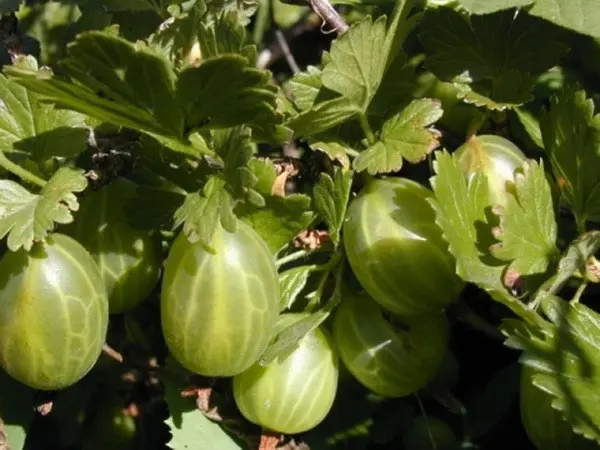
The gooseberry buds begin to swell at the first warming, and in the second half of April it is already turning green with blossoming leaves. Therefore, high-quality spring planting can be carried out only in a short period of time, until the buds are very full. The earth at this time has not yet dried out and it is not very pleasant to dig it. If you are late with planting, the plants will be very long and difficult to take root.
In the fall, gooseberries can be planted in accordance with all the rules, as there is enough time to properly prepare the pits without undue haste, select planting material and process its roots with high quality. After all, gooseberries are planted quite late, three weeks before the onset of stable cold weather. In Siberia, this time comes with the beginning of September, and in the southern regions, gooseberries can be planted from the end of October. The time remaining until frost will be enough for the plants to take root and grow stronger.
Video “Proper planting of a gooseberry bush”
From the video you will learn how to plant gooseberries.
Landing in the ground
Before planting a gooseberry, you need to think carefully about whether it will interfere when it grows and how comfortable it will be to care for it. They can compact tree plantings or place it next to the fence, provided that the shading is not complete. And yet, it is best to bear fruit gooseberries in an open, well-ventilated area. The occurrence of groundwater should be deep, at least 1.5 meters from the soil surface.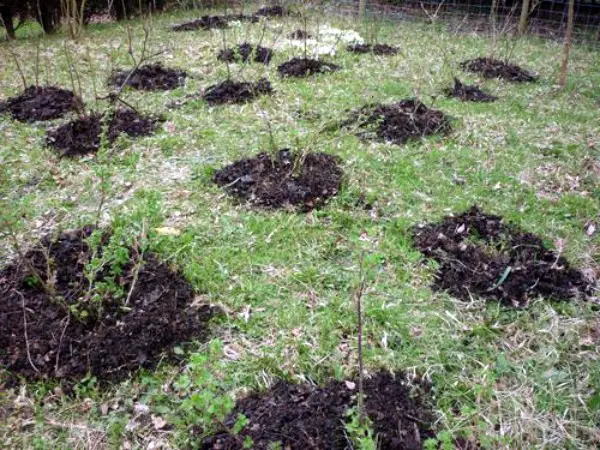
Excess moisture leads to root rot and fungal diseases. The site must be cleared of weeds, primarily from couch grass, which will be very difficult to deal with with further care. The soil should be rich in organic matter and have a neutral and slightly acidic reaction. Potatoes, beets, legumes are good predecessors. You can not plant it after raspberries. Planting gooseberries after and even next to currants can lead to damage by diseases and pests common to them.
First you need to choose the right seedlings. Preference is given to one- or two-year-olds, they take root more easily than older plants. A well-developed root system of two or three skeletal roots should be no shorter than 15 cm. The main shoot is one, and the height of the aerial part is not less than 40 cm.
Planting material should not have mechanical damage and visible signs of damage by diseases and pests. Plants dug up before the natural fall of the leaves have unripened shoots and most often freeze slightly, in addition, the main loss of moisture occurs through the leaves and such a specimen is likely to be overdried.
In this case, the seedling is freed from leaves before planting and soaked for a day in a nutrient solution (3-4 tablespoons of sodium humate per 5 liters of water). A normal, non-overdried plant does not need soaking, but before planting it must be dipped in a mash prepared according to this recipe:
- 5 L of water;
- 1 kg of clay;
- 1 kg of black earth;
- 1-2 packs of root growth stimulator “Kornevin”;
- a six-gram bag of “Aktara” – a systemic insecticide that will protect the bushes at first from the beetle, sawfly, moth and shoot aphids.
How to plant
For planting in the fall, pits are prepared in advance, the minimum size is 40x40x40, while the upper fertile layer is separated, and the lower, more meager one is laid next to it. A bucket of humus, 50 g of double superphosphate, 40 g of potassium sulfate or 200 g of wood ash are added to the fertile part of the soil, part of this mixture is poured into a slide at the bottom of the pit.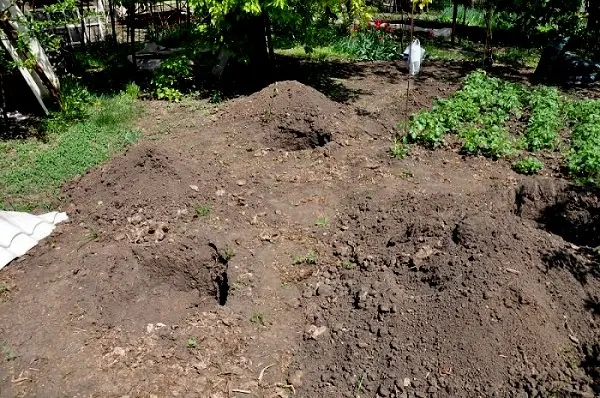
The roots of the plant, after preliminary pruning and dipping into the mash, are evenly spread over the entire area and sprinkled with the rest of the mixture. In this case, the root neck should be deepened by 2-3 cm, for the formation of basal shoots and an additional root system. This technique speeds up the formation of the bush. After watering, the earth will settle and must be topped up using the remaining less fertile soil. The root system of the gooseberry occupies a rather large area, so it is planted next to each other no closer than 1,5 m. In addition, this will simplify the care of an unusually prickly pet.
Transplant to a new place
Sometimes it becomes necessary to transplant an already adult bush growing in an inconvenient place. This should be done before bud break in spring or late fall. And in the fall it will be much more convenient. First, the bush is thoroughly cut, leaving 7 young strong shoots that must be immediately shortened by one third. It is dug around the perimeter of the crown, cutting off the roots along the way. Using a crowbar and a shovel, the bush is removed from the ground and placed on a piece of polyethylene.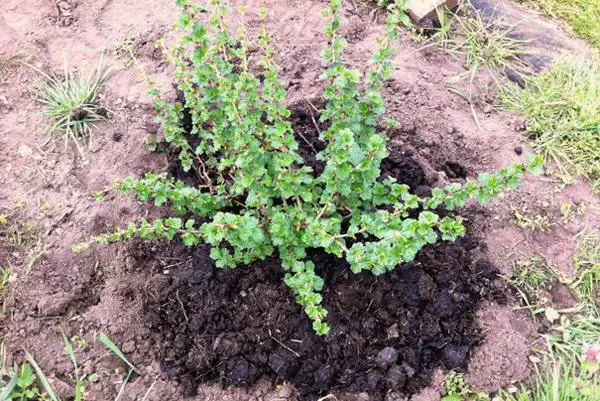
On a pre-selected site, they dig a hole commensurate with the root system of the migrant. The excavated soil is enriched with fertilizers, as described above. This food is designed for 3 years, in which the owner will be spared from additional care for the transplanted shrub. 2-3 buckets of water are poured into the pit and gooseberries are placed, falling asleep first with a nutrient mixture, and then with the remaining earth.
Trimming
Immediately after planting, the shoots are shortened, leaving 4-5 buds. Annual pruning has 2 goals – sanitary care and shaping. The gooseberry branches extremely, forming many young shoots to the detriment of fruiting. Caring for a running bush is very difficult. Sanitary-forming pruning is best done in the fall after leaf fall. First of all, damaged and diseased branches are completely removed. In the first year, the shoots of the current year are shortened by a third, and only 3-4 of the most powerful ones are left from the basal ones, growing in the right direction. In the second year, fresh shoots are shortened again, basal shoots are removed except for the 6-8 most developed ones. By the time of fruiting, in the third year, there are already from 12 to 15 branches of different ages. Young ones are shortened again and 3-4 basal ones are left. Starting from the age of 5-7, old branches are removed, distinguished by the dark color of the bark. Shortening the branches, the cut is made above the kidney located on the inside.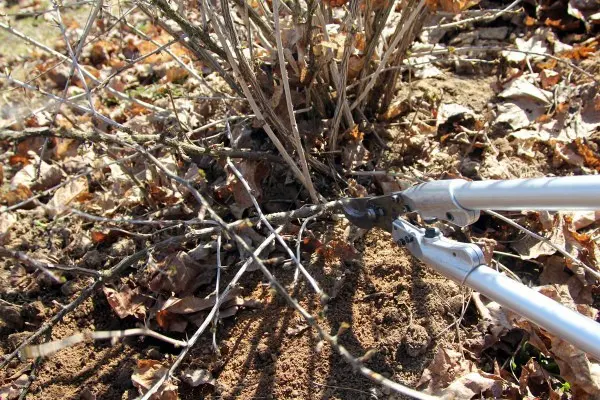
You can also rejuvenate an old thickened bush in the fall by removing two-thirds of the branches or cutting them all off, leaving 15-centimeter stumps so that young shoots can grow.
Care
Care for planted shrubs during the summer requires little – timely watering and shallow loosening. Another thing is caring for gooseberries in the fall, when the foundation for the future harvest is laid. First, remove all weeds under the bush and next to it. Carry out sanitary-forming pruning. Then the entire area around the gooseberry is cleared of leaves and plant debris.
The earth in the near-trunk circle is loosened, and they dig up in the aisle so that the approaching frosts destroy the insects wintering in it, simultaneously introducing 30 g of phosphorus and 20 g of potash fertilizers under each bush.
Preparation for winter
In September, you need to charge the plant with moisture to enhance root growth and successful wintering. To do this, a groove is dug near the shrub along the perimeter of the crown and water is let through it.
In autumn, it is necessary to treat the branches and the near-stem circle of the earth with fungicides from various fungal infections. Before the frosts, the ground under the plant is mulched with a 10-centimeter layer of peat or humus. This autumn care can be completed. In winter, you can cover the bushes growing in the open with snow, this will protect them from freezing.
Video “Preparing gooseberries in spring”
From the video you will learn what work to do in the spring to get a good harvest of gooseberries.









